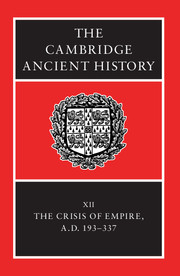Book contents
- Frontmatter
- PART I NARRATIVE
- PART II GOVERNMENT AND ADMINISTRATION
- 5 The army
- 6 The emperor and his administration
- 6a General developments
- 6b The age of the Severans
- 6c The government and administration of the empire in the central decades of the third century
- 6d The new state of Diocletian and Constantine: from the tetrarchy to the reunification of the empire
- 7a High classical law
- 7b Epiclassical law
- PART III THE PROVINCES
- PART IV THE ECONOMY OF THE EMPIRE
- PART V THE NON-ROMAN WORLD
- PART VI RELIGION, CULTURE AND SOCIETY
- Chronology
- Bibliography
- Index
- Topographical map of the Roman empire
- Map 2 The Roman empire in a.d. 211
- The Roman empire in a.d. 314
- The Rhine–Danube limes in the late second century
- References
6a - General developments
from 6 - The emperor and his administration
Published online by Cambridge University Press: 28 March 2008
- Frontmatter
- PART I NARRATIVE
- PART II GOVERNMENT AND ADMINISTRATION
- 5 The army
- 6 The emperor and his administration
- 6a General developments
- 6b The age of the Severans
- 6c The government and administration of the empire in the central decades of the third century
- 6d The new state of Diocletian and Constantine: from the tetrarchy to the reunification of the empire
- 7a High classical law
- 7b Epiclassical law
- PART III THE PROVINCES
- PART IV THE ECONOMY OF THE EMPIRE
- PART V THE NON-ROMAN WORLD
- PART VI RELIGION, CULTURE AND SOCIETY
- Chronology
- Bibliography
- Index
- Topographical map of the Roman empire
- Map 2 The Roman empire in a.d. 211
- The Roman empire in a.d. 314
- The Rhine–Danube limes in the late second century
- References
Summary
A long tradition of studies has represented the third century as a watershed, or at least as a moment of intersection separating two radically different, even opposed, worlds. More specifically with regard to the imperial authority, it has identified two different ways of governing the empire, of legitimating the exercise of imperial power and even of providing a selfrepresentation. According to this view, the clean break took the form of a ‘crisis’, which to a certain extent already revealed some of the weaknesses that eventually brought about the dissolution of a unified imperial organism in the west during the fifth century. It has also been held that such contrasting methods of exercising power corresponded to equally radical differences in how the administration was organized, at both central and peripheral levels. Indeed, it has even been claimed in a general way that it was during the fourth century, with the increasingly autocratic developments in imperial power, that we begin to detect a sharper distinction between government and administration, between political directive and administrative implementation – a distinction so characteristic of modern states with their division of powers.
According to this traditional view, therefore, the difference between the administrative organization of the principate and that of the late antique empire was both qualitative and quantitative. The second-century empire was run by provincial governors of senatorial rank, equestrian procurators and an extensive familia Caesaris. That of the third century, on the other hand, saw not only the increasing importance of staff from the army ranks, such as the beneficiarii operating in the legates' officia, but also the exclusion of senators from military command, a process that eventually – during the subsequent tetrarchic period – led to a clear separation of duties between the civil and military staff involved in provincial government.
- Type
- Chapter
- Information
- The Cambridge Ancient History , pp. 131 - 136Publisher: Cambridge University PressPrint publication year: 2005
References
- 2
- Cited by

